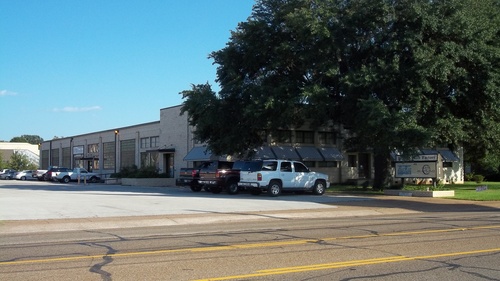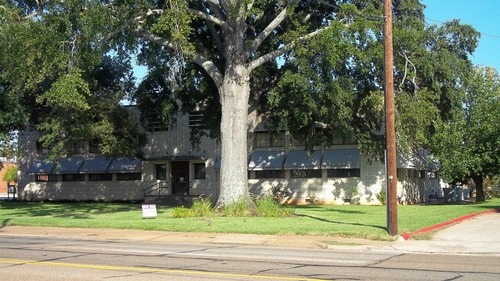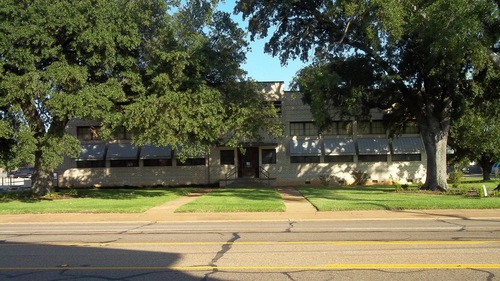412 North Photographs
412 North 2012 Survey
Click here for the 2012 survey form.412 North 2007 National Register Information
- Address: 412 North
- Name: Old Mize Factory
- Previous Name: Mize Factory
- Date: 1938
- Type: One part
- Contributing: Yes
This 1 1/2 story industrial building is characterized by its horizontal disposition, simple brick cladding and stylistic reference to Streamline Moderne. The primary façade faces west onto North Street, and is divided into three bays. The central bay projects both upward and forward from the elevation plane, and is flanked by two symmetrical bays. The flanking bays each contain two horizontal bands of four windows, each separated by vertical brick pilasters. Windows are multi-light metal casement, though glass block is also used on the north and south elevations. The public entrance to this building is on the West facade. This small double-door flanked on each side by a single window is located in the central bay. The entry is articulated by 4 columns of vertical brick banding, which extends from the parapet downward to the top of the entryway. The entrance is further marked by a simple, horizontal canopy hung on metal rods, a feature that is repeated at entrances placed on the north elevation of the building. The corner bays of building are edged with fluted pattern executed in brick. The water table and cornice areas are likewise ornamented with simple brickwork. The dominant banding pattern is created by alternating three rows of bricks in stringer position and one row in the ender position.
The Old Mize Factory was home to the Mize Manufacturing Company from 1938 to about 1992. The company was founded by Byron H. and W. Allan Mize, originally from Rose Pine, Louisiana. The Mize bothers moved to Nacogdoches in January 1925, after running general merchandise stores in both Huntsville and Crockett. After relocating to Nacogdoches, the brothers opened a variety store at the northwest corner of Main and Church, just west of Opera House. Their variety store did well, and as Lucy McBee reported in the Daily Sentinel, gave birth to a women's apparel factory. The venture began in 1927 when Allen Mize had a large quantity of dress ruffle on hand. In order to sell the excess material, Mize designed a dress made wholly of row after row of ruffle; merchants found this design so intriguing that they wanted not the trim, but the whole dress. The success of the garment, first stitched by Emma Watson (who in 1944 was still employed at the factory), encouraged the opening of the first Mize dress factory in 1928 over Golub's Shoe Shop on Church Street. With only three second-hand sewing machines, the employees focused on the manufacture of dress trimmings. Despite the onset of the Depression, the Mize Brothers did well, and in 1930 relocated their business to Elks building and began to manufacture women's dresses. The brothers designed all of the dresses sewn at their factory. Their garments met with almost immediate approval, in both the domestic and foreign markets. In order to stay abreast of recent trends, the Mizes made frequent trips to New York and other markets. Continued success led them to expand again, and to lease the Woodmen of the World Building (WOW, Property #55) in 1931. With a growing business, the brothers, with their partner E.C. Best, were encouraged to hire L.D. Pate as bookkeeper in 1937; Pate, and his daughter after him, would go on to be a partner in the venture. An increase in sales and the need for more floor space for both the Mize Brothers retail store and Mize Manufacturing led to the design and construction of a new facility in 1938. The new factory at 412 North Street contained 300,000 square feet of floor space, and was both heated and air-conditioned. Unlike the tight quarters available in the downtown commercial district, this new plant offered plentiful parking and a "beautifully landscaped," park-like lawn. Using their past experience as tenants turn-of-the-century buildings, the Mizes designed the new factory on one level, with efficient access for delivering raw materials and loading the finished product. The layout of the assembly line complimented a process in which materials entered at one door, fed into a U-shaped line, from which the completed dress would emerge at the opposite end.
Not only did the Mize Brothers business support nearly 100 families during the Depression, but it was considered the "only enterprise which contributes to the welfare of the community by furnishing employment on a considerable scale for women. Thus it affords a livelihood to many families who otherwise would lack the means of self support. By 1944, what began as one ruffled dress had grown to a company of over 200 employees. 264 In a 1943-44 promotional pamphlet titled "Mize Bros. Manufacturing Co., Makers of Ladies Coat Suits, Dresses, and Trimmings," the company was ranked among the local leaders in "industry which has built the city of Nacogdoches and added to its financial wealth."
In an effort to diversify, the Mize brothers and Best purchased the Mahdeen Company in 1941. In 1954, the brothers decided to split their assets, with Allen continuing to operate the Mize Dress Factory, and Byron retaining the department store and the Mahdeen Company (which he maintained until 1965 when he sold it to a drug firm in Dallas). Pate continued to work as the manager of the newly-named Mize Department Store, later becoming full partner. Jack Matthews was hired during this time, and was instrumental in later developments within the retail division. The department store eventually moved to the comer of Church and Main, and remained there until 1961, when the business relocated to its newly designed "modem" facility (and its present location) on Hospital Street.
The Mizes were known for their involvement in the community - they were active in both religious and civic affairs and their commitment to customer service. They offered extensive training to their employees, and often retained them for long periods of time. The Mize Factory was in operation until the 1980s; after the company closed, the factory building remained empty until the Social Security Administration took up residence in 1994.
412 North 1986 Survey Information
- Address: 412 North
- Date: 1940
- Block: 2
- Lot: 23
- Condition: Good
- Description: 2-story; load-bearing masonry; brick foundation; rectangular plan; flat roof with parapet, stone coping; 3-bay front facade, 8-bay side facade; facades are broken up by "Chicago style" steel windows, multipaned with operable awning sash, (1) on west (front) by alternating bands of brick coursing, 3 stretcher courses to one header course (English bond), and central entry; (2) on north (side) by alternating pilasters and bays of windows. Front corners of the building are accentuated by a fluted effect of vertical alternating header and stretcher courses. The front facade is balanced with four sets of windows on either side of the slightly extended entrance. The parapet steps up above the entrance, four narrow columns of raised header brick flanked by horizontal louvers terminated above a suspended metal entry canopy; a centered wood panel and glass entry door with narrow side lights is flanked by square windows; MIZE BROS. MANUFACTURING CO. is across the front in large blue enamel letters. The front lawn has large oaks; a narrow service drive on the north leads to a loading dock with a "car siding" door and a side entry. Both entries have a suspended metal canopy with ornamental hook plates in the wall.
- Significance: Architectural.


